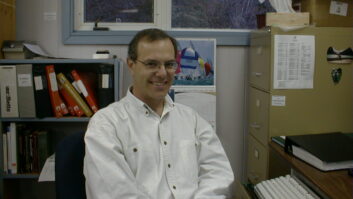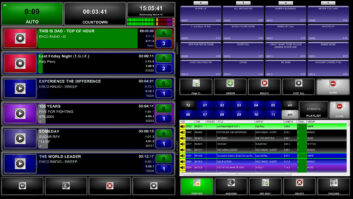Okay, stop holding your breath. The rumors are true: Cool Edit Pro really is Adobe Audition now, and has been for some time.
CEP has taken root in thousands of radio stations, radio network operations and news facilities everywhere. Clear Channel stations swear by it (see sidebar). Never mind how little it costs; the thing is an amazing performer, no matter what name it is offered under. And now it is under the Adobe roof.
Product CapsuleThumbs Up:
Everything that made CEP a hit
Comes with a real softcover manual
Customizable shortcuts
Sample rates to 10 MHz
Thumbs Down:
Graphics need some freshening up
Incompatible with VST plug-ins unless wrapper is used
Price: $299
Contact: the Adobe Systems website at www.adobe.com
Adobe, the company behind the free Acrobat PDF file reader and author of Adobe Premiere Pro video editing software, knew a good thing when it saw it. It acquired the multitrack audio environment from Syntrillium Software last year to offer customers an audio editor with the same bang as Premiere and that would integrate fairly seamlessly with it as well.
As CEP had gone through several years of R&D courtesy of Syntrillium, Adobe picked up a ready-made product with a loyal user base. But this unfortunately spelled doom for other products in the Syntrillium line; it ended production on the Red Rover hardware controller box and eliminated the rudimentary Cool Edit 2000, a staple of newsroom operations.
The good news for newsies is that an upgrade from Cool Edit 2000 to the full Adobe version is only $99, less than the price of a portable MD recorder.
Current CEP users may not be in a hurry to upgrade, as a majority of the features remain the same. New users who have heard the buzz about Cool Edit will be joining a large family now using one of the most popular editors ever.
Still, there are enough freshened elements found in Audition that may convince you to take the plunge, whether a grizzled vet or a CEP newbie.
First look
For the uninitiated – and where have you been? – Adobe Audition is the latest incarnation of a powerful 128-track audio editor that functions as both multitrack recorder and mixing environment.
It includes dozens of high-quality DSP effects and can incorporate many more third-party processing plug-ins conforming to the Microsoft DirectX standard.
It can create thousands of royalty-free production music beds with the exclusive Loopology music samples and loops. Audition comes with a music content CD filled with loops from the old Syntrillium loopology.com Web site, plus thousands more from the pay-per-loop CDs and from unreleased collections.
(click thumbnail)Fig. 1: The Edit View of Adobe Audition, looking quite familiar.
On its face (literally), Audition looks much the same as CEP did in its final incarnation (see Fig. 1) and offers the same sample-accurate editing capabilities as the earlier versions, with sample rates up to 10 MHz (!) depending on your audio interface.
It is in the subtle collection of features, many beneficial to broadcast production, that makes Audition worth a long and serious look. Some migrated over from CEP, some are new, but all are handy to have in your arsenal.
It is safe to assume you know how to record and edit a waveform and have seen a multitrack environment, so let me instead focus on features of interest in Adobe Audition.
Still Cool
Among the innovations in the latest release, there finally is a mixer window (Fig 2.).
At one time, users depended solely on rubberband curves called Envelopes to set levels, panning and Effect wet/dry mixes. You may continue doing that, but now you can click open a mixer for a more hands-on feel to the mix.
(click thumbnail)Fig. 2: Multitrack View and Mixer
Audition can save you a ton of time when doing one of those “no breath” voice tracks (where pauses and breathing are removed). The Delete Silence function in the Edit menu detects and removes silence between words and phrases, tightening up copy without manually highlighting and cutting multiple pauses.
Speaking of saving time, do you find yourself doing a lot of Normalizing on multiple files? Hit Group Waveform Normalize and watch all open files top out at the exact percentage you assign. Users of the Batch File Convert function will understand and appreciate that.
One feature I especially liked, carried over from the days when the standard was SAWPlus from IQS, is single-keystroke shortcuts. The most important functions of that program were implemented with the keyboard more so than with a mouse click.
Audition took that philosophy and improved on it. Not only do you have a long list of stock key shortcuts to pick from (Space = Stop/Start), but you can write your own to fit your speed – like “R” launching the reverb or “ALT+D” opening the Dynamics processor.
While more of a video and audio-for-film feature, Audition carried over the Multichannel Encoder from CEP, allowing the creation of 5.1 Surround Sound audio. You will never need it for radio, but it’s a gas to use if your studio allows it.
Audition also allows the insertion of WAV Properties for embedding text and information. In other words, cart label.
Click the Radio Industry tab under this menu heading and enter all relevant information such as client, outcue, run dates and more. If your automation system can read and convert this field to its own format, you are good to go.
Effects
The Dynamics Processing effect in CEP has been ported over to Audition and offers everything from gentle peak limiting to severe squish and gating. Voices sound great, and the ability to draw the knee and set levels graphically is enormously appealing.
As useful as this effect is, I wish Adobe had retooled the interface from a numerical-entry window to one with virtual knobs. Typing in values and hoping something sounds right is hit-or-miss at best, and I would rather spin a dial and hear the result. There are plenty of third-party plug-in processors that do this already. Maybe in the next version …
The same observation could be made about the Echo Chamber, which offers the ability to adjust the size of virtual “rooms” and placement of microphones through numerical data entry. A wireframe room graphic is not difficult to generate, and I would be more inclined to experiment with this effect if I could see a room and put a mic … right … here.
One of my favorite dramatic effects is an AM radio-ish sound that slowly transitions to a “real-life” full bandwidth sound; imagine an old movie where a closeup of a loudspeaker dissolves to a live announcer in the studio while he is speaking.
Formerly done in the Multitrack View by crossfading between two copies of the same audio file, this can now be handled by the Morph and Transition functions found under the FFT Filter, and applied to only one file. Drag some edit points on a graph and the filter goes from 300 Hz-3 kHz response to full fidelity over time. Nicely done.
(click thumbnail)Fig 3: The Track EQ window vs. the Para EQ: Which sliders do you prefer?
Speaking of filters, the Parametric EQ offers enormous filtering possibilities, outstanding control and a list of useful presets that can come to your rescue anytime. But it too suffers from the same blah interface as the Echo and Dynamics do, along with the same Windows slider controls seen since Win 3.1. In my opinion, the Track EQ window in the Multitrack View (Fig. 3) better represents what this feature should look like in the basic Edit View.
Audition allows third-party DirectX plug-ins to help in the creative process. High-quality reverbs and software emulations of classic gear such as Urei compressors and tube preamplifiers are abundant and many can be found for free on the Internet.
To my disappointment, both Syntrillium and Adobe opted to leave out Steinberg Virtual Studio Technology (VST) plug-in compatibility. VST plug-ins are likewise abundant on the Web, and dozens are offered for free.
It is possible to use a wrapper – a small bit of code that makes a VST plug-in “look” like a DirectX plug-in – but these are not always stable and add another layer of complexity to the creative process.
Old favorites
Some functions from earlier days suddenly take on new usefulness the more you work with them.
The Frequency Analysis window, for example, displays a graph of frequencies occurring at the cursor position or in the center of a highlighted block.
With it, you can finally see and dial out the exact frequency of that annoying high-frequency whistle that hitched a ride on TV audio or in a data-compressed file. If your eye is more refined than most, you might be able to observe the differences in characteristics when A/B’ing a pair of microphones for studio use.
For no good reason, I ran an old recording of the rooftop siren from my hometown fire department through the Frequency Analysis window. The graph revealed not one but two pitches in the file, spaced a musical fourth apart. Growing up hearing the siren for some 22 years, I never noticed the hidden pitch until I saw it.
The Pitch Bender is back again for those classic rundown turntable effects. Convolution lets you lay an impulse down on existing WAVs for some serious mind-twisting effects. And there are three methods for generating reverb.
Impressions
Old-line users may never cozy up to the new name. “Audition” commonly refers to a switch position on an audio console. Many users I know continue to call it “Cool Edit” out of habit. This may persist for awhile, so I hope the Adobe folks have a sense of humor about it.
There may always be a schism between the Pro Tools and CEP crowds. The former slams the “unreliable” and “crash-prone” Windows platform, while the latter boasts of how little they paid for their computers. Pro Tools also includes MIDI functions that CEP users may never bother to explore.
I have said it before: You can be brilliant with any program on any platform. It’s not the hammer, it’s the carpenter, so to me the whole CEP/Pro Tools argument is a moot one.
Audition runs on a minimum 400 MHz PC with Win98SE or better, but you’ll need to pack a lunch and your razor while it renders a reverb transform. For best performance, load it into a 2 GHz or better machine under WinXP, with all the RAM you can muster.
If there are any areas where Adobe can improve Audition, let it be in changing the GUIs on some of the effects to more resemble hardware we are familiar with (knobs, buttons) and less like a Windows Visual Basic project (numbers, sliders).
Also, it is time to let VST join the party. Many useful VST effects deserve to be recognized and allowed compatibility with Audition without the need for buggy DX/VST “wrappers” to assist.
If I could wish for one effect to be added, it would be an easy-to-understand multiband compressor-limiter, much like what is used for mastering a recording. These sound great on voice, and while the stock dynamics processor has a band-limiting tab, it just isn’t the same.
To its credit, Adobe kept the price of Audition at a reasonable $299. Even better, the upgrade from CEP 2.0 or 2.1 is free, so registered users can make the switch without dropping a nickel.
When compared to editors of an earlier era that did much less, this is a remarkable accomplishment. Put another way, did you ever imagine you could afford a 128-track production system for the price of a bicycle? And install it on a “digital recording device” you could obtain at an office supply store?
By the way, Adobe reprised last year’s bouncing ball “Easter egg,” concealed in the Help>About window. Expert users will know where to look; casual users will just have to hunt for it. Sorry.
Passed the audition
Will Audition survive as is or will it get folded into the more prominent video product Premiere, just as Sony blended Sonic Foundry’s Vegas audio editor into the Vegas video version? I hope for the sake of those of us doing audio-only work, the company keeps the products separate. But it’s a changing world and the lines between media types are blurring, so let’s all wait and see.
If you are already using CEP, you are fine for a while. But the itch is going to get to you and you will want to upgrade before long, especially since it is free to do so.
If you are not already a user of either CEP or Audition, download the demo from the Adobe Web site ( www.adobe.com ) and give it a spin. And let me be the first to welcome you to the family.










